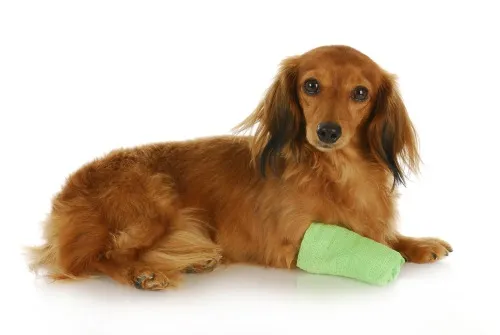Key Takeaways
- Puppy paws are especially vulnerable to cuts, burns, and scrapes.
- Determine if the injury is minor or severe enough to see a vet.
- Clean the wound with cool water, diluted saline solution, or an Epsom salt soak.
- Apply an antibacterial ointment to paw wounds.
- Bandage wounded paws with gauze or a wrap and cover with a bootie for protection.
Pets rely on their paws to stay active and healthy. The paw pads are generally up to the challenge, but accidents such as cuts, burns, scrapes and other abrasions are bound to happen. The risk is even higher for puppies, whose paws are especially tender.
 Pet parents can follow these tips to treat paw ailments — and get their pet back on all fours in no time:
Pet parents can follow these tips to treat paw ailments — and get their pet back on all fours in no time:
Determine the Severity
There are many hazards that can injury a pet’s paw. Rough surfaces such as gravel can slice through the paw padding, while hot concrete during the summer can cause burns. The natural environment, too, poses risks since sticks, bushes and burrs can cause cuts. In other cases, pets are their own worst enemies. Pets that lick or gnaw on their paws can cause cuts and cracking.
The first treatment step is to determine the severity of the injury. Head to the veterinarian for deep cuts or more serious injuries. If the wound is superficial, try these simple treatments:
Home Remedies 101
Step 1: Clean the wound. The Daily Puppy recommends that pet parents rinse the wound with cool water or a diluted saline solution. An Epsom salt soak is another option to soothe an animal’s pain. Be careful to not rub the wound.
For pets suffering from paw burns, Pedigree recommends that owners apply an ice pack to the burn, or run the affected paw under cool water.
Step 2: Once the paw is dry, apply an antibacterial ointment. Dr. Henry Cerny, a Nebraska-based veterinarian at the Yankee Hill Veterinary Hospital, recommends Vetericyn or Neosporin in a post on Cesar Millan’s blog.
Step 3: Bandage the paw with gauze or a pet bandage wrap. For added protection, cover the bandage with a loose sock or a pet bootie, though be sure not to cinch the cover too tightly as it could restrict blood circulation.
Clean the bandages daily, and monitor the wound closely. If it isn’t healing properly, or if the wound becomes infected, the next stop should be a vet for an expert opinion. Any sort of accidental injury is going to be covered by pet insurance.
The content is not intended to be a substitute for professional veterinarian advice, diagnosis, or treatment. Always seek the advice of your veterinarian or other qualified health provider with any questions you may have regarding a medical diagnosis, condition, or treatment options.







